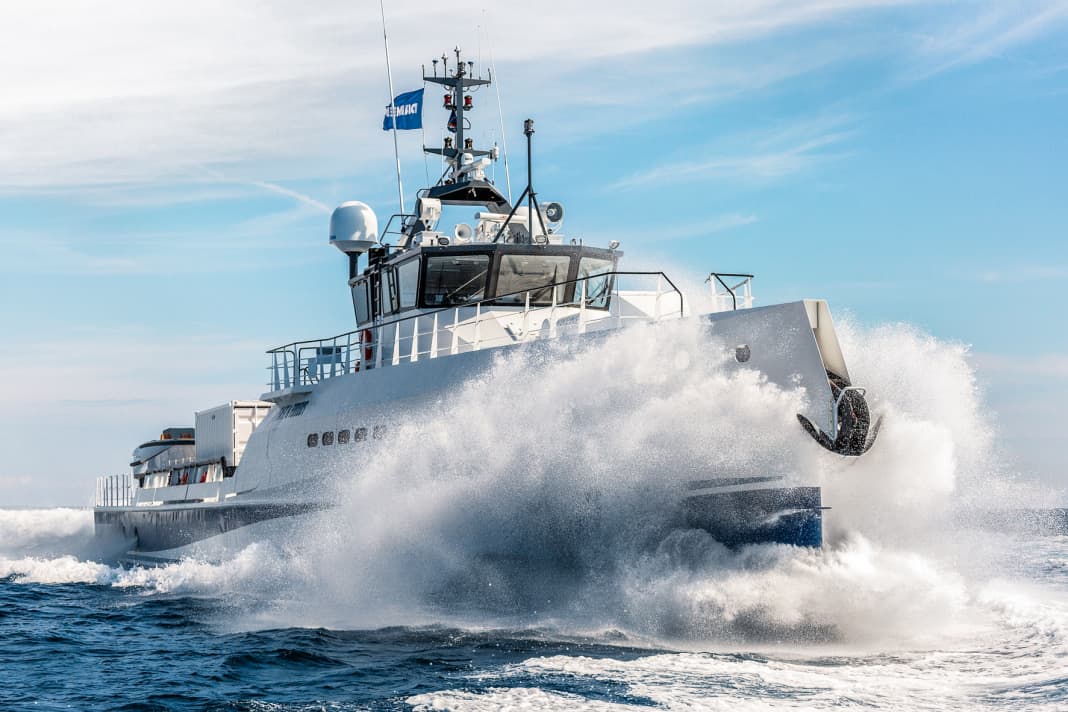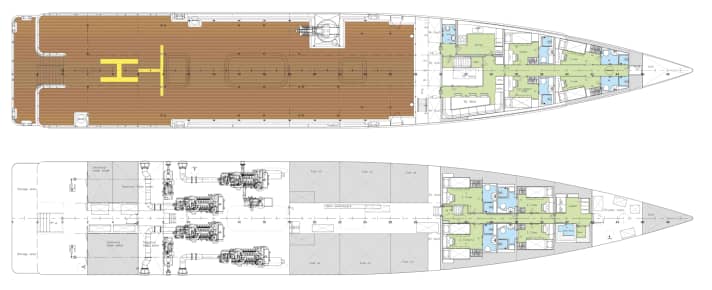





The trend towards so-called shadow yachts is not entirely new. For around ten years, some owners have had their yachts followed by supply ships that transport large tenders, submarines or other equipment that absolutely have to be taken on voyages but do not fit on the mother ship. Prominent examples include the "Al Said" (155 metres), which is followed by the 164-metre-long "Fulk Al Salamah" - it is intended to park ten cars in the military hospital, for example - or the "Ace" (87 metres), which is supported by the 67-metre-long "Garçon". However, as impressive as these convoys may be, their owners are very shy. Publications or foreign visitors? No, thank you.
"That didn't make it any easier for us to sell," says Victor Caminada from Amels, whose parent company Damen, one of the largest shipyard conglomerates in the world, supplied the "Garçon", for example, as well as the very similar "Umbra" and "Pursuit", "Intrepid" and "6711". For around six years, Amels and Damen have been active as market leaders in this niche market, in which offshore supply vessels and Coast Guard ships are customised and equipped for the yacht market. In the absence of a showpiece, the Dutch company made the famous move last summer and delivered "Fast & Furious", a show supply vessel without an owner, which was presented to potential customers at the trade fairs in Monaco and Fort Lauderdale. While it had to somewhat subordinate itself to the general hustle and bustle and novelty hype in the Principality, it really stands out under the Florida sun.
"Fast & Furious" with crane on board
The crane on deck alone is a statement - it rises to a height of 19 metres (!) and has the capacity to lift a maximum of 5.5 tonnes when extended. The shipyard has made the 55-metre-long ship completely open to the public, with a constant stream of visitors moving across the deck, where a 20-foot container, a submarine and two respectable tenders are parked. Victor Caminada, who will explain the concept of Damen's so-called Yacht Support Vessel in detail, is also standing here. "Last night," he says by way of welcome, "we had a party here with 300 guests. Everyone was allowed to keep their shoes on. And if a drink was spilt, we just smiled gently." My gaze immediately wanders over the 225 square metre (!) aft deck. "This is not natural teak," explains Caminada, "but an artificial covering, Esthec. It's a kind of casting compound into which joints are later cut and which is extremely robust. Wipe it away, done." Pretty much everything about "Fast & Furious" seems robust anyway.
We start the tour on the bridge to avoid the current hustle and bustle on deck. Due to its design and purpose, the wheelhouse is located relatively far forward. Almost all of the electronics are from Alphatron; from three comfortable chairs - the centre one with integrated throttle levers and joysticks - the captain and his crew have a 360-degree view of the action. If you look ahead, you can see a very high and slim bow, which reminds you of the construction of "Fast & Furious" and a total of 200 similarly built offshore vessels. Together with the University of Delft and the Maritime Research Institute Netherlands, Damen developed a special axe bow that is not only efficient but also extremely seaworthy. At the same time, the supply vessel boasts a maximum top speed of 22 knots and is therefore probably faster than almost any "mother ship". A total of 4472 kilowatts from four Caterpillar engines (3512C TA) propel the 55 metres to this value. "High performance," says Victor Caminada, "is extremely important. After all, the yacht supporter has to arrive at the destination in advance, for example to launch the tender or prepare the submarine." On a trip from Monaco to Porto Cervo (almost 200 nautical miles), such a difference - mother ship runs at 14 knots, supplier at 22 knots - makes up around six hours.
On the way to the technical heart of "Fast & Furious", we pass the saloon, which the shipyard has kept quite sober, as the future owner should have complete freedom of choice here. "Anything is possible here," emphasises Victor Caminada. "We can install cabins for additional crew, VIP accommodation, a beautiful saloon or even additional storage space. If there is not enough space, the superstructure can be extended aft." This would involve extra costs, but with a base price of 13.5 million euros for these 55 metres, it would certainly be affordable for most customers.
The focus is on the experience on board the "Fast & Furious"
With such a low basic price, wouldn't it also be conceivable to equip such a ship with an upscale interior and offer it to young, adventurous owners as a first yacht? "Of course!" says Caminada. "We see a new generation of owners who don't necessarily prioritise ownership, but rather the experience. There is a smaller sister to this 55-metre version that we recommend to precisely these interested parties - 43 metres long and designed as an adventure and expedition yacht." The brochure is appropriately presented and uses headings such as "Cool machine" or "Wild weekend". Activities such as heli-skiing, deep-sea fishing and wildlife watching in unspoilt terrain are described.
Both models, the 43-metre version and the "Fast & Furious", rely on components that have already proven themselves hundreds of times in practice. "When a ship like this is travelling in the oil industry, it clocks up around 7,000 operating hours per year. As it also sails in areas such as off Nigeria or in the Gulf of Mexico, all the units have to be extremely reliable and easy to repair," says Victor Caminada, explaining the principle of the engine room, which takes up almost the entire lower deck. In addition to the four engines, there are three generators, a power pack for the crane alone and the usual equipment. The layout is spacious and easy to maintain; the route ahead leads past the control board and huge tanks. They hold a total of 230,000 litres of diesel and enable a range of 5,000 nautical miles at a cruising speed of 16 knots. Back in the fresh air, the lugs on the deck catch the eye. "We can use them to strap down 10, 20 or 40-foot containers," says Caminada. In addition to the helicopter (full helipad optional), the submarine and the tender, there is also one on "Fast & Furious" to demonstrate the variety of uses. The grey box houses professional diving equipment including a decompression chamber. However, it could just as easily be used to store sails or extensive fishing equipment. Caminada adds:
We even install helicopter hangars or garages for your favourite car."
By the way, the delivery time for such a ship is only eight months...
Technical data
- Length over everything:55,30 m
- Waterline length:54,00 m
- Width:9,25 m
- Depth:3,90 m
- Gross tonnage: 465
- Material: Steel, aluminium
- Motor:Caterpillar 3512C TA
- Engine power: 4 x 1118 kW
- Speed (max.):22 kn
- Speed (travelling):16 kn
- Fuel: 230 000 l
- Range:5000 nm @ 16 kn
- Water: 30 000 l
- Deck area (free):225 square metres
- Navigation:Alphatron
- Construction: Ladies
- Interior design: Ladies
- Classification: Bureau Veritas
- Shipyard:Ladies/Netherlands, 2016
- Price: 13.5 million euros


This article appeared in BOOTE EXCLUSIV issue 01/2017 and was revised by the editorial team in May 2023.

